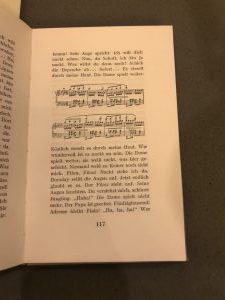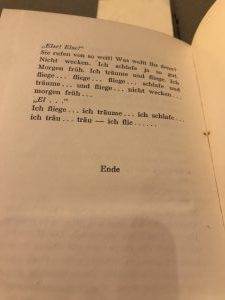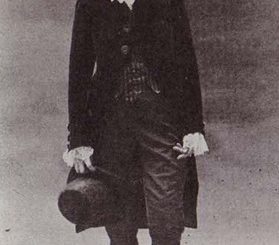Fräulein Else: German Edition by Cass T.
Object—Fräulein Else (1924, Deutsch)
The object associated with Arthur Schnitzler is a small, green edition of Fräulein Else, published in 1924. Set in its original German, the novelle stands at over a hundred pages, calling into question its classification as “short fiction.” However, while it may not seem particularly short, the time frame during which the story takes place makes it possible–and perhaps preferable–to read in one sitting, moving it from the form of “novel” to “novelle.” To read it as a novel would imply natural stopping points in the text for a longer interaction with the piece, but its style makes it a quick read—the colloquial language and stream-of-consciousness narration taking the reader easily through the pages. The story follows the thoughts of a teenaged girl in early 20th-century Austria, who is staying at a hotel in the country when her parents call to ask for her help in getting out of debt, requesting, in not so many words, that she sleep with an older man for his money. The story is frank, relatable, and captures the colloquial voice of a teenage girl with ease.
In fact, the story in its original setting is even more casually written than one may assume from the English translation. Schnitzler’s truncation of verbs (particularly from “ich habe” to “ich hab’;” see image 1) in the first person is an  indication, not only of Else’s young age, but also a class separation between her and her peers; commonly, German writing, particularly about the upper class, avoids such a colloquial style of writing, and one that visually captures an accent or verbal tick, which is something that could possibly be overlooked in English. To miss this is to miss a deeper insight into Else’s psyche, namely, that she feels set apart through her speech from the rest of the residents of the hotel by virtue of her social class and upbringing.
indication, not only of Else’s young age, but also a class separation between her and her peers; commonly, German writing, particularly about the upper class, avoids such a colloquial style of writing, and one that visually captures an accent or verbal tick, which is something that could possibly be overlooked in English. To miss this is to miss a deeper insight into Else’s psyche, namely, that she feels set apart through her speech from the rest of the residents of the hotel by virtue of her social class and upbringing.
Something that may be startling to English speakers about the German version is the style of quotation: the German quotes begin with a „ and end with a “ (seen in image 2 and 4), the clear visual delineation of which allows Schnitzler  to enhance his stream-of-consciousness style by not separating speech with a paragraph break, making it an easier integration into the stream-of-consciousness form of the text. All speech is in one paragraph of text; the only clear visual differences being dashes between each quote, and the use of italics for anyone who is not Else speaking. The difference in italicization also helps to separate Else from the people she speaks with, both in terms of the “other,” and in regards to her social status in comparison to theirs. The large block of spoken word, however, allows the reader to experience Else’s full attention on the speech, and then the abrupt jump in return to her inner monologue with the break of the paragraph.
to enhance his stream-of-consciousness style by not separating speech with a paragraph break, making it an easier integration into the stream-of-consciousness form of the text. All speech is in one paragraph of text; the only clear visual differences being dashes between each quote, and the use of italics for anyone who is not Else speaking. The difference in italicization also helps to separate Else from the people she speaks with, both in terms of the “other,” and in regards to her social status in comparison to theirs. The large block of spoken word, however, allows the reader to experience Else’s full attention on the speech, and then the abrupt jump in return to her inner monologue with the break of the paragraph.
One of the particularly interesting parts of Fräulein Else is its jump from language and storytelling in words to the addition of sheet music close to the climax of the novelle. Something that has been discussed in the context of  transcending the written word to more closely approximate the true nature of human thought. What is especially worth noting in Fräulein Else however, is the different places in the writing that Schnitzler and various translators and publishers choose to insert the music. Traditionally it is all done within the climax, but the exact location varies; in the version that we read for class, the music actually comes a page or so later than in the original (images 2 and 3), located while the music is actually playing in the scene, while other versions allow the music to stop before the last bit of sheet music is inserted. This changes the reading of what the music is intended to mean; when it is during the playing of the piano, it is much more clearly supposed to be a translation of the auditory to visual, a pure representation of thought; when it is elsewhere, it is harder to get at its exact meaning.
transcending the written word to more closely approximate the true nature of human thought. What is especially worth noting in Fräulein Else however, is the different places in the writing that Schnitzler and various translators and publishers choose to insert the music. Traditionally it is all done within the climax, but the exact location varies; in the version that we read for class, the music actually comes a page or so later than in the original (images 2 and 3), located while the music is actually playing in the scene, while other versions allow the music to stop before the last bit of sheet music is inserted. This changes the reading of what the music is intended to mean; when it is during the playing of the piano, it is much more clearly supposed to be a translation of the auditory to visual, a pure representation of thought; when it is elsewhere, it is harder to get at its exact meaning.
Naturally, every story must come to its end. The broken nature of the English translation is the same in the original,  but Schnitzler chose to complete his work definitively, with the word “Ende.” (image 4) While this may just be a
but Schnitzler chose to complete his work definitively, with the word “Ende.” (image 4) While this may just be a
stylistic device commonly used in the time, if it is not, the finality of this ending helps to contribute to the true finality of Else’s death. She has not merely fallen asleep, she is well and truly dead. Any ambiguity feels lost upon the reading of this word, as do many things with the addition of this original text.










Recent Comments